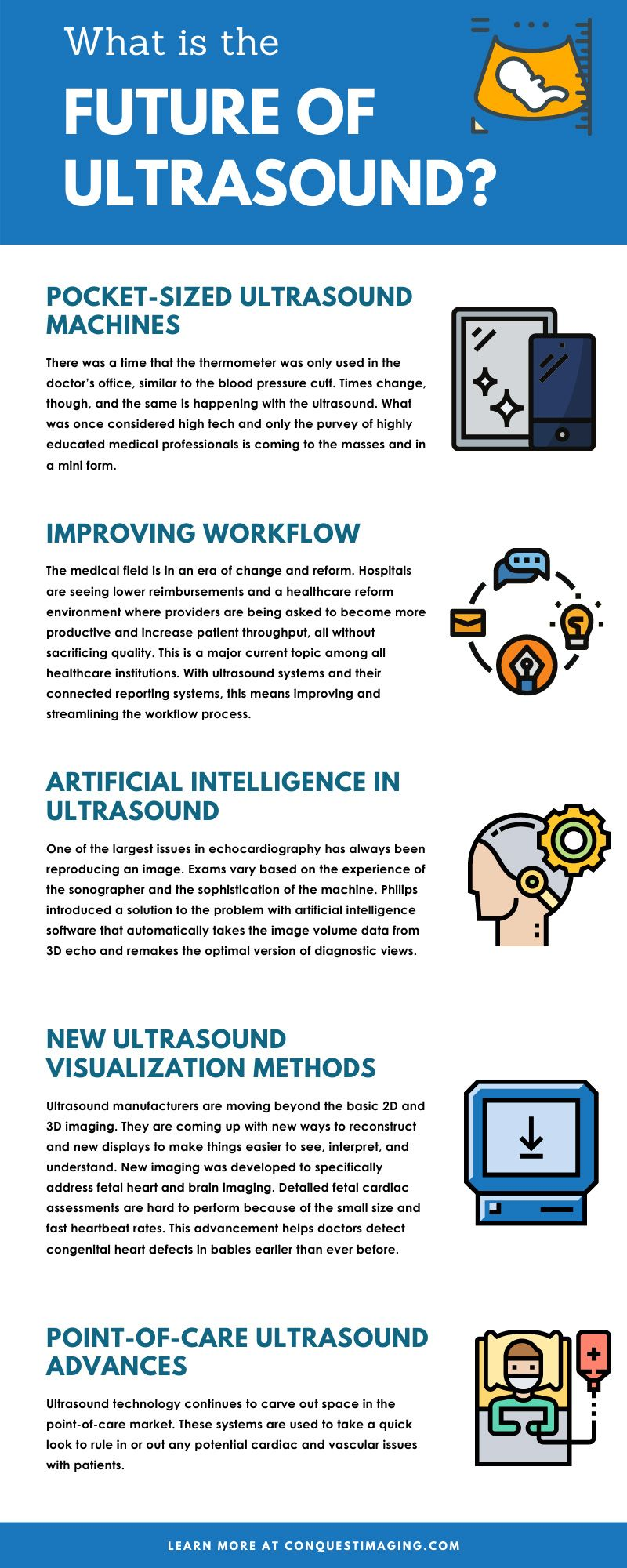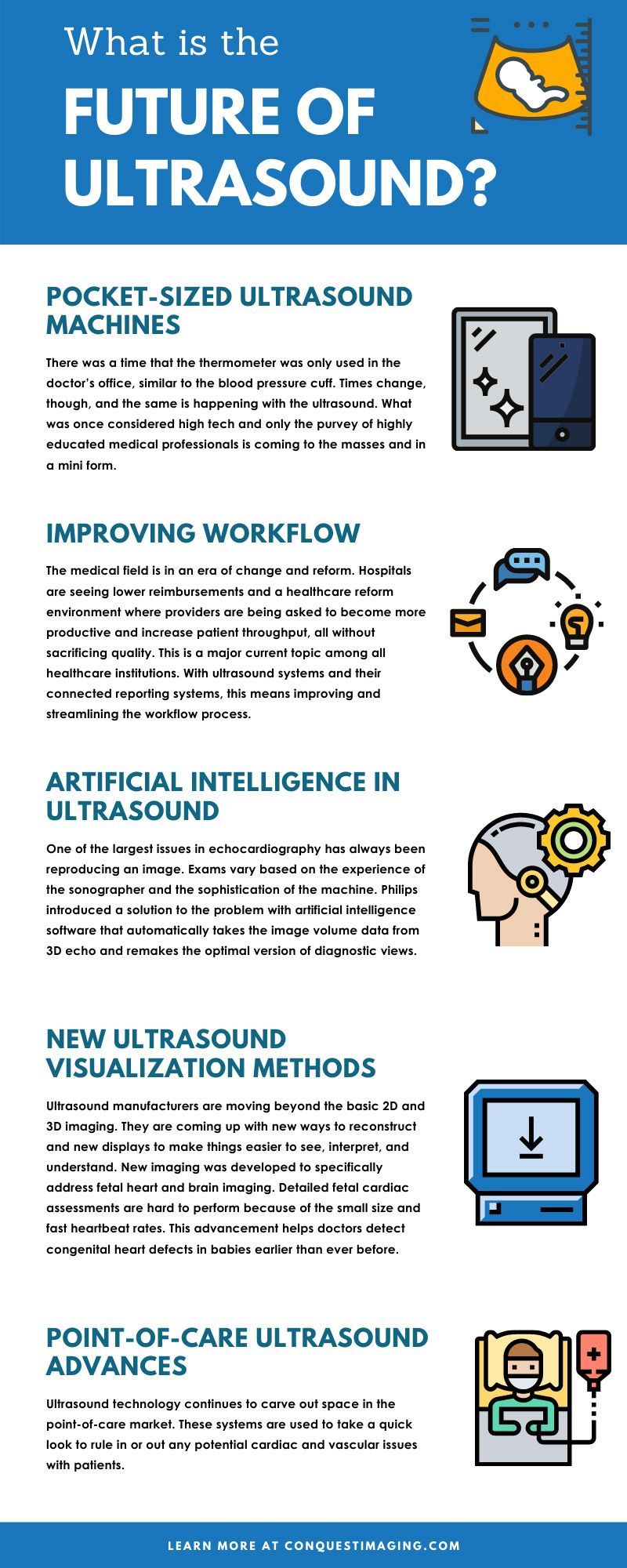
What is the Future of Ultrasound?
The impact of ultrasound technology has grown as new uses demonstrate their usefulness in a variety of settings. What is the future of ultrasound?
Fri Oct 30 2020
Start Date:
End Date:

Ultrasound is more accessible than ever; the utility of ultrasound extends across the entire continuum of care and has become fundamental to providing cost-effective care for patients around the world. Though ultrasound originated within traditional imaging, novel point-of-care applications are now being performed and are contributing to better patient care that is safer and more economical than traditional imaging. Advances like AI and 4D imaging are leading to crispers images and more efficient data collection. Doctors can see more now than ever before. There is a growing body of evidence about the benefits of the point-of-care ultrasound and why it should be standard care for many diseases. An ultrasound gives clinicians incredible insight into patients’ bodies and allows them to diagnose, intervene, treat, and monitor the condition of patients closely. Even though it was invented around 100 years ago, this is still relatively young technology. The impact of ultrasound technology has grown as new uses demonstrate their usefulness in a variety of settings. What is the future of ultrasound?
POCKET-SIZED ULTRASOUND MACHINES
There was a time that the thermometer was only used in the doctor’s office, similar to the blood pressure cuff. Times change, though, and the same is happening with the ultrasound. What was once considered high tech and only the purvey of highly educated medical professionals is coming to the masses and in a mini form. Someone figured out how to put ultrasound technology on a chip that connects to an iPhone app. Now a smaller handheld version is available for sale around the world and brings this life-saving technology to places that could never previously afford it. The smaller machines won’t replace the larger, more powerful linear probe ultrasounds found in hospitals, but they will make medical imaging much more routine. The larger, more advanced machines will always have a home in the emergency room and in clinics because they are capable of more functions. The smaller ones will simply make ultrasound imaging more affordable and easier to use.
IMPROVING WORKFLOW
The medical field is in an era of change and reform. Hospitals are seeing lower reimbursements and a healthcare reform environment where providers are being asked to become more productive and increase patient throughput, all without sacrificing quality. This is a major current topic among all healthcare institutions. With ultrasound systems and their connected reporting systems, this means improving and streamlining the workflow process. Next-generation ultrasound machines have features like fewer dropdown menus, fewer keystrokes, faster processing times, and the automation of measurements. Those might seem like trivial changes that don’t amount to much, but they adds up over time. When less time is spent clicking buttons and scrolling through dropdowns, more time is spent on the patient. They get a better level of care while the technician is able to do their job more effectively. The future isn’t adding more features, it’s getting rid of superfluous buttons and increasing speed.
ARTIFICIAL INTELLIGENCE IN ULTRASOUND
One of the largest issues in echocardiography has always been reproducing an image. Exams vary based on the experience of the sonographer and the sophistication of the machine. Philips introduced a solution to the problem with artificial intelligence software that automatically takes the image volume data from 3D echo and remakes the optimal version of diagnostic views. Philips called their innovation the Anatomically Intelligent Ultrasound (AIUS) suite technology and it debuted on their Epiq 7 cardiovascular ultrasound machine. It uses the 3D data to automatically compute measurements to help clinicians easily assess disease states and determine treatment options. Compared to 2D exams, this can gather and compute dimensions three to six times faster than manual or semi-automated methods.
NEW ULTRASOUND VISUALIZATION METHODS
Ultrasound manufacturers are moving beyond the basic 2D and 3D imaging. They are coming up with new ways to reconstruct and new displays to make things easier to see, interpret, and understand. New imaging was developed to specifically address fetal heart and brain imaging. Detailed fetal cardiac assessments are hard to perform because of the small size and fast heartbeat rates. At 18 weeks, the fetal heart is the size of an olive and beats about 150 times a minute. The structure is complex, and the baby is in constant motion, making it hard to hit a moving target. GE Healthcare’s fetalHQ helps evaluate the fetal heart shape and size in less than three minutes. This advancement helps doctors detect congenital heart defects in babies earlier than ever before.
POINT-OF-CARE ULTRASOUND ADVANCES
Ultrasound technology continues to carve out space in the point-of-care market. These systems are used to take a quick look to rule in or out any potential cardiac and vascular issues with patients. Philips Healthcare opened a new segment of the market when it introduced Lumify. It’ the first mobile app-based ultrasound system. The app turns any Android-based smartphone or tablet into a portable ultrasound imaging device. All you have to do is plug a transducer probe in the device’s USB port. The transducer performs all of the acquisition functions and some of the image reconstruction, while the digital device serves as the screen to view the images on.
The Future of Ultrasound
What is the future of ultrasound? Industry insiders foresee continued advancements in ultrasound technology oriented toward cost-effective solutions that do not compromise high-quality imaging. The ultrasound will become even more automated, mobile, definitive, and intuitive for users, making it an indispensable everyday tool for patient diagnosis and care. Despite significant advancements in technology, ultrasound education has remained relatively stagnant. Students aren’t learning the new systems and are still focused on the older technology. If the up-and-coming techs can’t keep up with the pace of innovation, then there is little point in advancing technology. So much has evolved, and the medical curricula are not keeping pace. Especially in health care, sometimes we get so swept up by the excitement of new features and gadgets that we forget that the primary purpose of any imaging solution is to help the clinician better understand what is happening with their patient. One of the unique characteristics of the ultrasound, separating it from other imaging modalities, is the way in which it allows a clinician to remain present with his or her patient at the bedside, preserving the important human connection which is so key to effective diagnosis and care.
Conquest Imaging is your home for Philips, GE, and Siemens ultrasound machines. Contact us today to find out what we can do for you.

